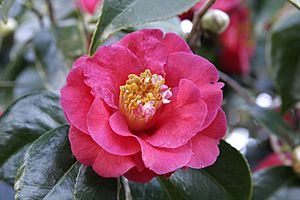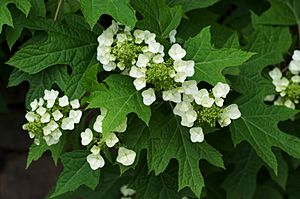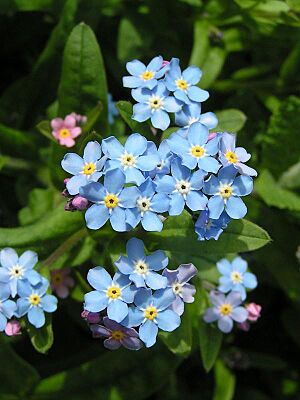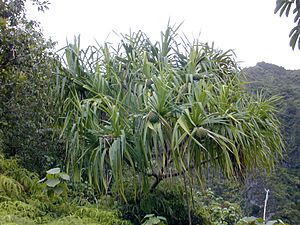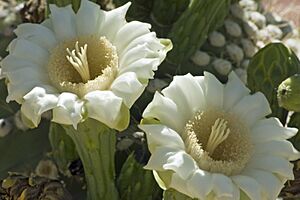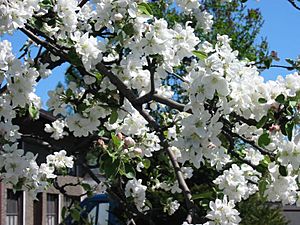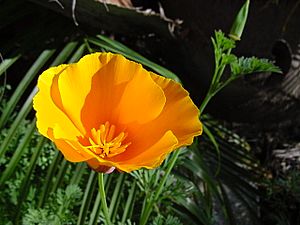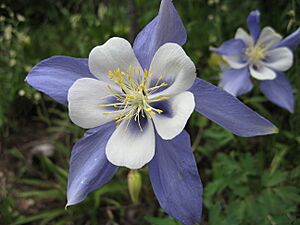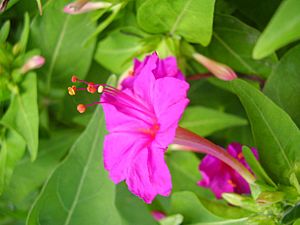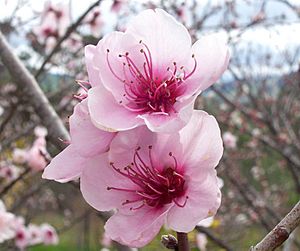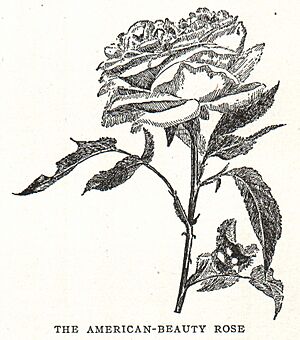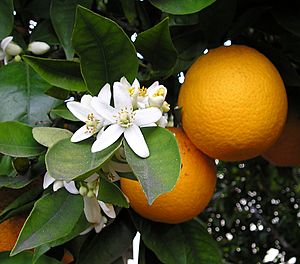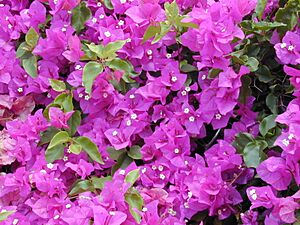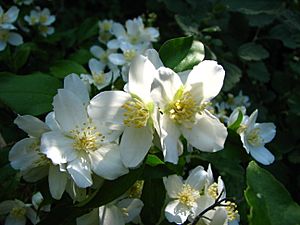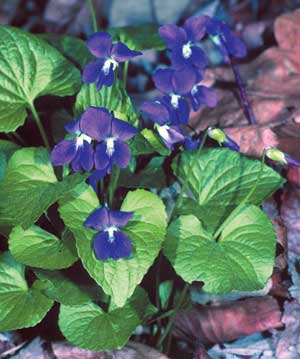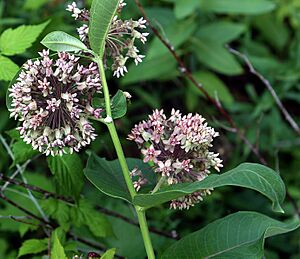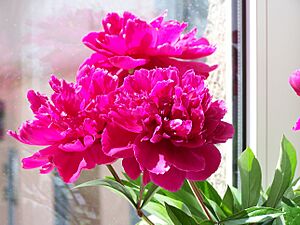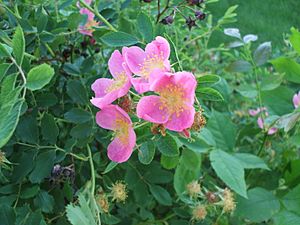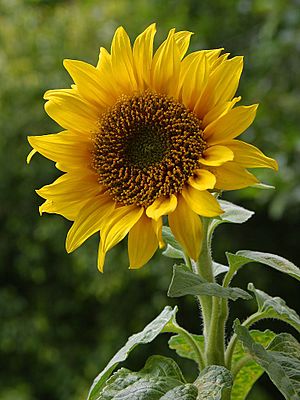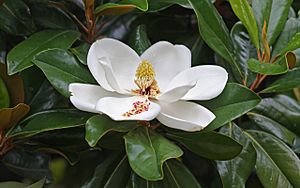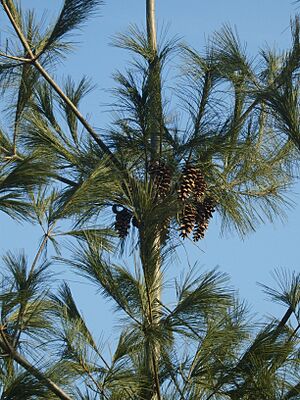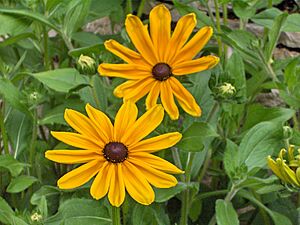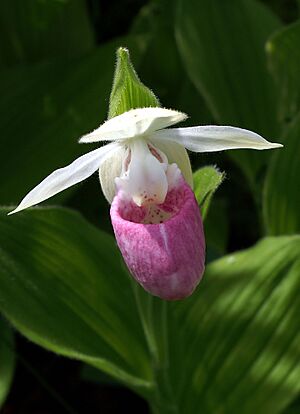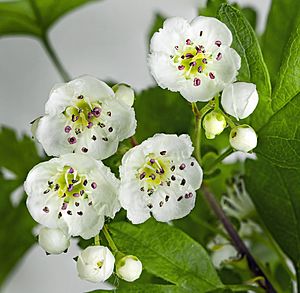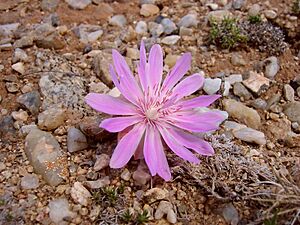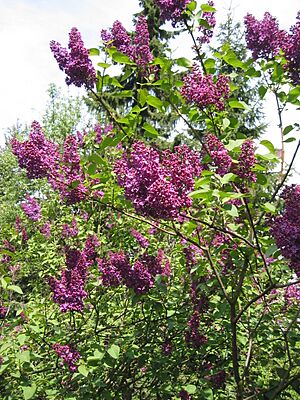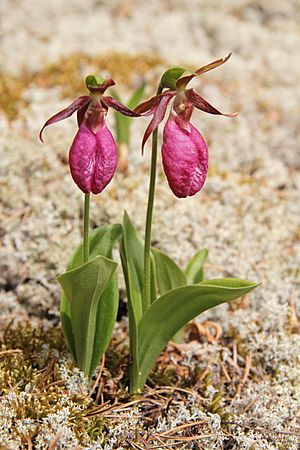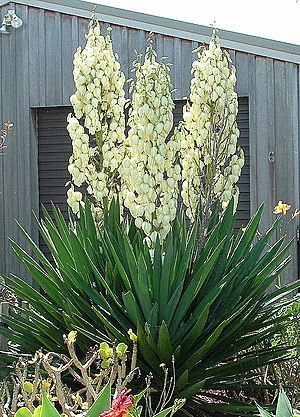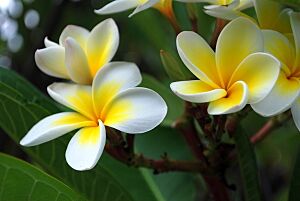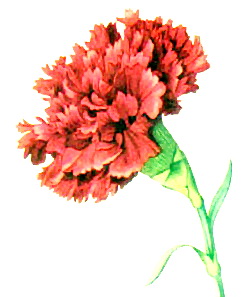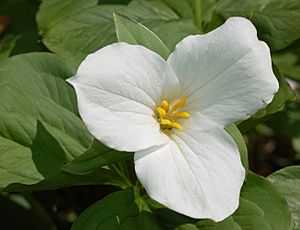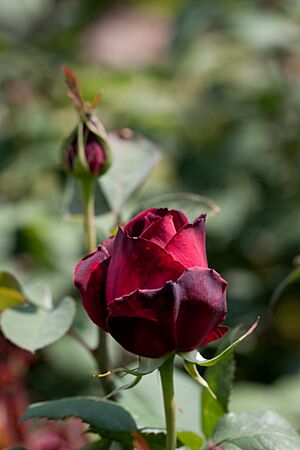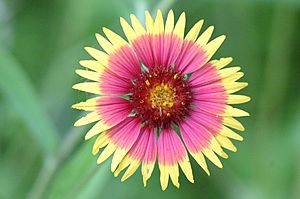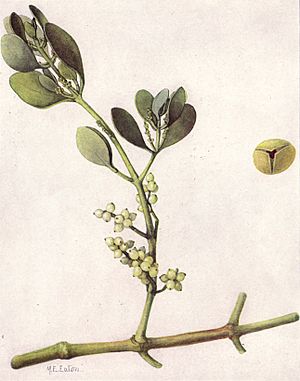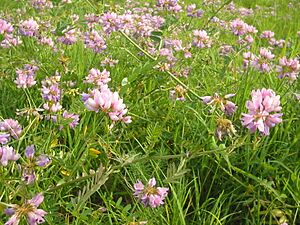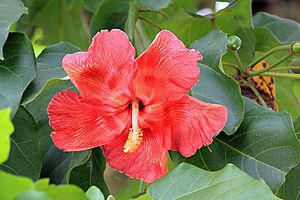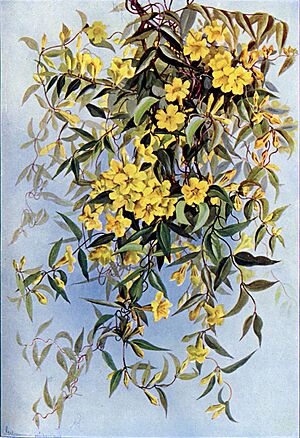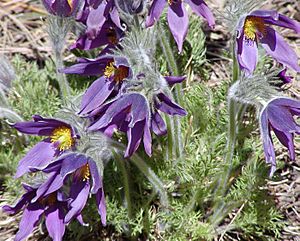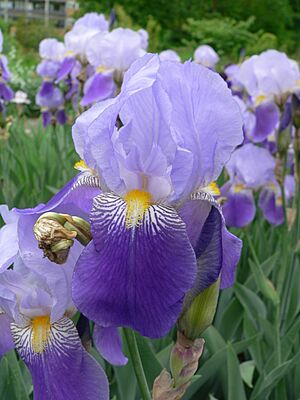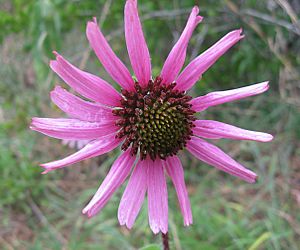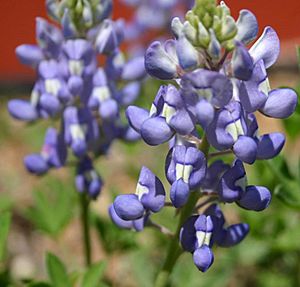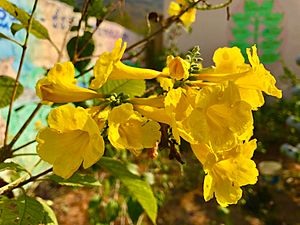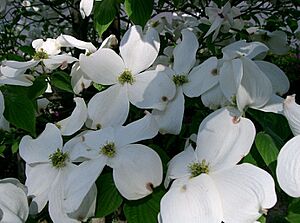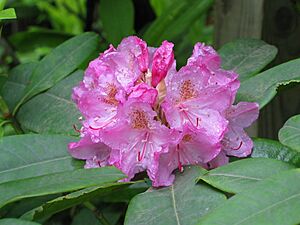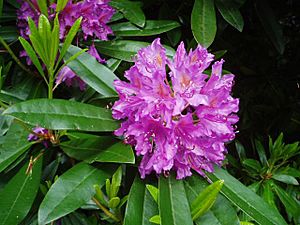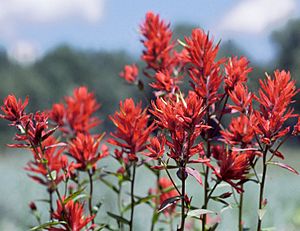List of U.S. state and territory flowers facts for kids
This is a list of U.S. state, federal district, and territory flowers.
Did you know that every U.S. state, federal district, and territory has its very own special flower? These flowers are chosen to represent the unique beauty and history of each place. They are often picked because they grow naturally there or have a special meaning to the people. These official flowers are symbols of pride and heritage, much like a state flag or bird.
Contents
- State Flowers of the United States
- Alabama
- Alaska
- American Samoa
- Arizona
- Arkansas
- California
- Colorado
- Connecticut
- Delaware
- District of Columbia
- Florida
- Georgia
- Guam
- Hawaii
- Idaho
- Illinois
- Indiana
- Iowa
- Kansas
- Kentucky
- Louisiana
- Maine
- Maryland
- Massachusetts
- Michigan
- Minnesota
- Mississippi
- Missouri
- Montana
- Nebraska
- Nevada
- New Hampshire
- New Jersey
- New Mexico
- New York
- North Carolina
- North Dakota
- Northern Mariana Islands
- Ohio
- Oklahoma
- Oregon
- Pennsylvania
- Puerto Rico
- Rhode Island
- South Carolina
- South Dakota
- Tennessee
- Texas
- Utah
- Vermont
- U.S. Virgin Islands
- Virginia
- Washington
- West Virginia
- Wisconsin
- Wyoming
- See also
State Flowers of the United States
Alabama
Alabama has two official flowers!
- The Camellia (Camellia japonica) became the state flower in 1959. It's a beautiful, often pink or white flower that blooms in winter.
- The Oak-leaf hydrangea (Hydrangea quercifolia) was named the state wildflower in 1999. It has unique cone-shaped white flowers and leaves that look like oak leaves.
Alaska
- Alaska's state flower is the Forget-me-not (Myosotis alpestris), chosen in 1917. This tiny, blue flower is a symbol of remembrance and can be found growing wild in Alaska's mountains.
American Samoa
- The Paogo or Ulafala (Pandanus tectorius) is the official flower of American Samoa, chosen in 1973. This plant is important in Polynesian culture and its fruits are often used in leis.
Arizona
- The Saguaro cactus blossom (Carnegiea gigantea) became Arizona's state flower in 1931. This large, white flower blooms at night on the giant saguaro cactus, which is a symbol of the American Southwest.
Arkansas
- Arkansas chose the Apple blossom (Malus) as its state flower in 1901. Apple trees are common in Arkansas, and their delicate pink and white blossoms signal the arrival of spring.
California
- The California poppy (Eschscholzia californica) is California's vibrant state flower, adopted in 1903. Its bright orange petals can be seen covering hillsides across the state in springtime.
Colorado
- Colorado's state flower is the Colorado blue columbine (Aquilegia coerulea), chosen in 1899. This beautiful flower has blue and white petals and grows high in the Rocky Mountains.
Connecticut
Connecticut has two special flowers:
- The Mountain laurel (Kalmia latifolia) became the state flower in 1907. It's a lovely evergreen shrub with clusters of pink or white flowers.
- The Four-O’Clocks (Mirabilis jalapa) were named the children's state flower in 2015. These flowers are special because they open in the late afternoon.
Delaware
- The Peach blossom (Prunus persica) was chosen as Delaware's state flower in 1953. Delaware is known for its delicious peaches, and the blossoms are a beautiful sight in spring.
District of Columbia
- The American Beauty Rose (Rosa) became the flower of the District of Columbia in 1925. This classic red rose is a symbol of beauty and love.
Florida
Florida also has two official flowers:
- The Orange blossom (Citrus sinensis) is Florida's state flower, adopted in 1909. These fragrant white flowers come from orange trees, a major crop in Florida.
- Tickseed (Coreopsis spp.) was named the state wildflower in 1991. These bright yellow flowers are common throughout Florida.
Georgia
Georgia has two floral emblems:
- The Cherokee rose (Rosa laevigata) is Georgia's state floral emblem, chosen in 1916. This white rose is known for its beauty and its connection to the history of the state.
- The Azalea (Rhododendron) was named the state wildflower in 1979. Azaleas are popular garden plants with colorful blooms.
Guam
- The Bougainvillea spectabilis is Guam's official flower, adopted in 1968. This plant is known for its bright, papery bracts (which look like petals) in shades of pink, purple, and red.
Hawaii
- The Hawaiian hibiscus (Hibiscus brackenridgei), also called maʻo hau hele, became Hawaii's state flower in 1988. This bright yellow hibiscus is native to the islands.
Idaho
- Idaho's state flower is the Syringa or mock orange (Philadelphus lewisii), chosen in 1931. This shrub produces beautiful, fragrant white flowers in late spring.
Illinois
Illinois has two official flowers:
- The Violet (Viola) was chosen as the state flower in 1907. These small, often purple flowers are common throughout Illinois.
- Milkweed (Asclepias spp.) was named the state wildflower in 2017. Milkweed plants are very important because they are the only food source for monarch butterfly caterpillars.
Indiana
- The Peony (Paeonia) became Indiana's state flower in 1957. Peonies are popular garden flowers known for their large, showy blooms in many colors.
Iowa
- Iowa's state flower is the Wild rose (Rosa arkansana), adopted in 1897. This hardy rose grows wild across the prairies of Iowa.
Kansas
- The Sunflower (Helianthus annuus) was chosen as Kansas's state flower in 1903. Sunflowers are famous for their tall stalks and large, bright yellow heads that follow the sun.
Kentucky
- Kentucky's state flower is the Goldenrod (Solidago gigantea), adopted in 1926. This plant produces tall stalks covered in tiny, bright yellow flowers in late summer and fall.
Louisiana
Louisiana has two official flowers:
- The Magnolia (Magnolia) became the state flower in 1900. Magnolia trees are known for their large, fragrant white flowers and shiny green leaves.
- The Louisiana iris (Iris giganticaerulea) was named the state wildflower in 1990. These beautiful irises come in many colors and grow in the wetlands of Louisiana.
Maine
- Maine's state flower is the White pine cone and tassel (Pinus strobus), chosen in 1895. This unique choice highlights the importance of the white pine tree to Maine's history and economy.
Maryland
- The Black-eyed susan (Rudbeckia hirta) is Maryland's state flower, adopted in 1918. These cheerful yellow flowers with dark centers are common throughout the state.
Massachusetts
- The Mayflower (Epigaea repens) became Massachusetts's state flower in 1918. This small, fragrant pink or white flower blooms very early in spring.
Michigan
Michigan has two official flowers:
- The Apple blossom (Malus) was chosen as the state flower in 1897. Like Arkansas, Michigan also celebrates the beauty of apple tree blooms.
- The Dwarf lake iris (Iris lacustris) was named the state wildflower in 1998. This rare, small blue iris grows only along the shores of the Great Lakes.
Minnesota
- The Pink and white lady's slipper (Cypripedium reginae) is Minnesota's state flower, officially adopted in 1967. This beautiful and rare orchid is protected by law.
Mississippi
Mississippi also has two official flowers:
- The Magnolia (Magnolia) became the state flower in 1900, officially enacted in 1952. Its large, creamy white flowers are iconic in the South.
- Tickseed (Coreopsis) was named the state wildflower in 1991. These bright flowers add color to Mississippi's landscapes.
Missouri
- The Hawthorn (Crataegus) was chosen as Missouri's state flower in 1923. Hawthorn trees produce small, white flowers in spring and red berries in fall.
Montana
- Montana's state flower is the Bitterroot (Lewisia rediviva), adopted in 1894. This tough little flower has pink petals and grows in rocky, dry areas.
Nebraska
- The Goldenrod (Solidago gigantea) became Nebraska's state flower in 1895. Like Kentucky, Nebraska also celebrates this common and cheerful yellow wildflower.
Nevada
- Nevada's state flower is the Sagebrush (Artemisia tridentata), chosen in 1967. While not a showy flower, sagebrush is a very important plant in Nevada's desert ecosystem.
New Hampshire
New Hampshire has two official flowers:
- The Purple lilac (Syringa vulgaris) became the state flower in 1919. Lilacs are known for their beautiful purple flowers and sweet scent.
- The Pink lady's slipper (Cypripedium acaule) was named the state wildflower in 1991. This unique orchid has a pouch-like petal that looks like a slipper.
New Jersey
- The Violet (Viola sororia) was chosen as New Jersey's state flower in 1971. These small, often purple flowers are a common sight in gardens and wild areas.
New Mexico
- New Mexico's state flower is the Yucca flower (Yucca), adopted in 1927. Yucca plants have tall stalks with clusters of creamy white, bell-shaped flowers.
New York
- The Rose (Rosa) became New York's state flower in 1955. The rose is a classic symbol of beauty and is grown in many varieties.
North Carolina
North Carolina has two official flowers:
- The Flowering dogwood (Cornus florida) was chosen as the state flower in 1941. Dogwood trees are famous for their lovely white or pink "flowers" (which are actually modified leaves) in spring.
- The Carolina lily (Lilium michauxii) was named the state wildflower in 2003. This beautiful orange-red lily is native to the southeastern United States.
North Dakota
- North Dakota's state flower is the Wild prairie rose (Rosa blanda or arkansana), adopted in 1907. This hardy rose thrives on the open prairies.
Northern Mariana Islands
- The Flores mayo (Plumeria) is the official flower of the Northern Mariana Islands, chosen in 1979. Plumeria flowers are very fragrant and often used in leis.
Ohio
Ohio has two official flowers:
- The Scarlet carnation (Dianthus caryophyllus) became the state flower in 1953. This bright red flower is a symbol of love and remembrance.
- The Large white trillium (Trillium grandiflorum) was named the state wildflower in 1987. This striking white flower has three petals and three leaves.
Oklahoma
Oklahoma has three special floral symbols!
- The Oklahoma rose (Rosa) was chosen as the state flower in 2004. This specific rose variety is known for its deep red color and strong fragrance.
- The Indian blanket (Gaillardia pulchella) was named the state wildflower in 1986. These colorful flowers have petals in shades of red, orange, and yellow, resembling a woven blanket.
- Mistletoe (Phoradendron leucarpum) was chosen as the state floral emblem in 1893. Mistletoe is a parasitic plant that grows on trees and is often associated with holidays.
Oregon
- Oregon's state flower is the Oregon grape (Mahonia aquifolium), adopted in 1899. This plant has clusters of yellow flowers in spring and blue berries in summer.
Pennsylvania
Pennsylvania has two official flowers:
- The Mountain laurel (Kalmia latifolia) became the state flower in 1933. Like Connecticut, Pennsylvania also celebrates this beautiful shrub.
- The Penngift crown vetch (Coronilla varia) was named the beautification and conservation plant in 1982. This plant is used to prevent soil erosion.
Puerto Rico
- The Flor de Maga (Thespesia grandiflora) is Puerto Rico's official flower, chosen in 2019. This large, showy flower is native to the island and has a beautiful red color.
Rhode Island
- Rhode Island's state flower is the Violet (Viola), adopted in 1968. These small, charming flowers are a popular choice for several states.
South Carolina
South Carolina has two official flowers:
- The Yellow jessamine (Gelsemium sempervirens) became the state flower in 1924. This vine produces fragrant, bright yellow flowers in early spring.
- The Goldenrod (Solidago altissima) was named the state wildflower in 2003. This tall plant with yellow flowers is common in many parts of the state.
South Dakota
- The Pasque flower (Pulsatilla hirsutissima) is South Dakota's state flower, adopted in 1903. This early-blooming purple flower is one of the first signs of spring on the prairies.
Tennessee
Tennessee has three official flowers!
- The Iris (Iris) was chosen as the state cultivated flower in 1933. Irises are known for their beautiful, complex flowers in many colors.
- The Purple passionflower (Passiflora incarnata) was named state wildflower 1 in 1919. This unique vine produces intricate purple and white flowers.
- The Tennessee purple coneflower (Echinacea tennesseensis) was named state wildflower 2 in 2012. This rare coneflower is native only to certain parts of Tennessee.
Texas
- The Bluebonnet sp. (Lupinus sp.) is Texas's state flower, adopted in 1901. These beautiful blue flowers cover fields across Texas in spring, creating stunning landscapes.
Utah
- Utah's state flower is the Sego lily (Calochortus nuttallii), adopted in 1911. This delicate white or purple flower was an important food source for early settlers.
Vermont
- The Red clover (Trifolium pratense) became Vermont's state flower in 1894. Red clover is a common plant in fields and is important for agriculture.
U.S. Virgin Islands
- The Yellow Elder (Tecoma stans) is the official flower of the U.S. Virgin Islands, chosen in 1934. This plant produces clusters of bright yellow, trumpet-shaped flowers.
Virginia
- Virginia's state flower is the American dogwood (Cornus florida), adopted in 1918. Like North Carolina, Virginia also celebrates this beautiful tree with its distinctive spring blooms.
Washington
- The Coast rhododendron (Rhododendron macrophyllum) is Washington's state flower, officially adopted in 1959. This large shrub produces beautiful pink or purple flowers.
West Virginia
- West Virginia's state flower is the Rhododendron (Rhododendron maximum), adopted in 1903. This evergreen shrub is known for its large clusters of white or pink flowers.
Wisconsin
- The Wood violet (Viola papilionacea) became Wisconsin's state flower in 1909. This small, purple flower is a common sight in woodlands and gardens.
Wyoming
- Wyoming's state flower is the Indian paintbrush (Castilleja linariifolia), adopted in 1917. These vibrant red or orange flowers are common in the western United States.
See also
 In Spanish: Anexo:Flores de los estados de EE. UU. para niños
In Spanish: Anexo:Flores de los estados de EE. UU. para niños


